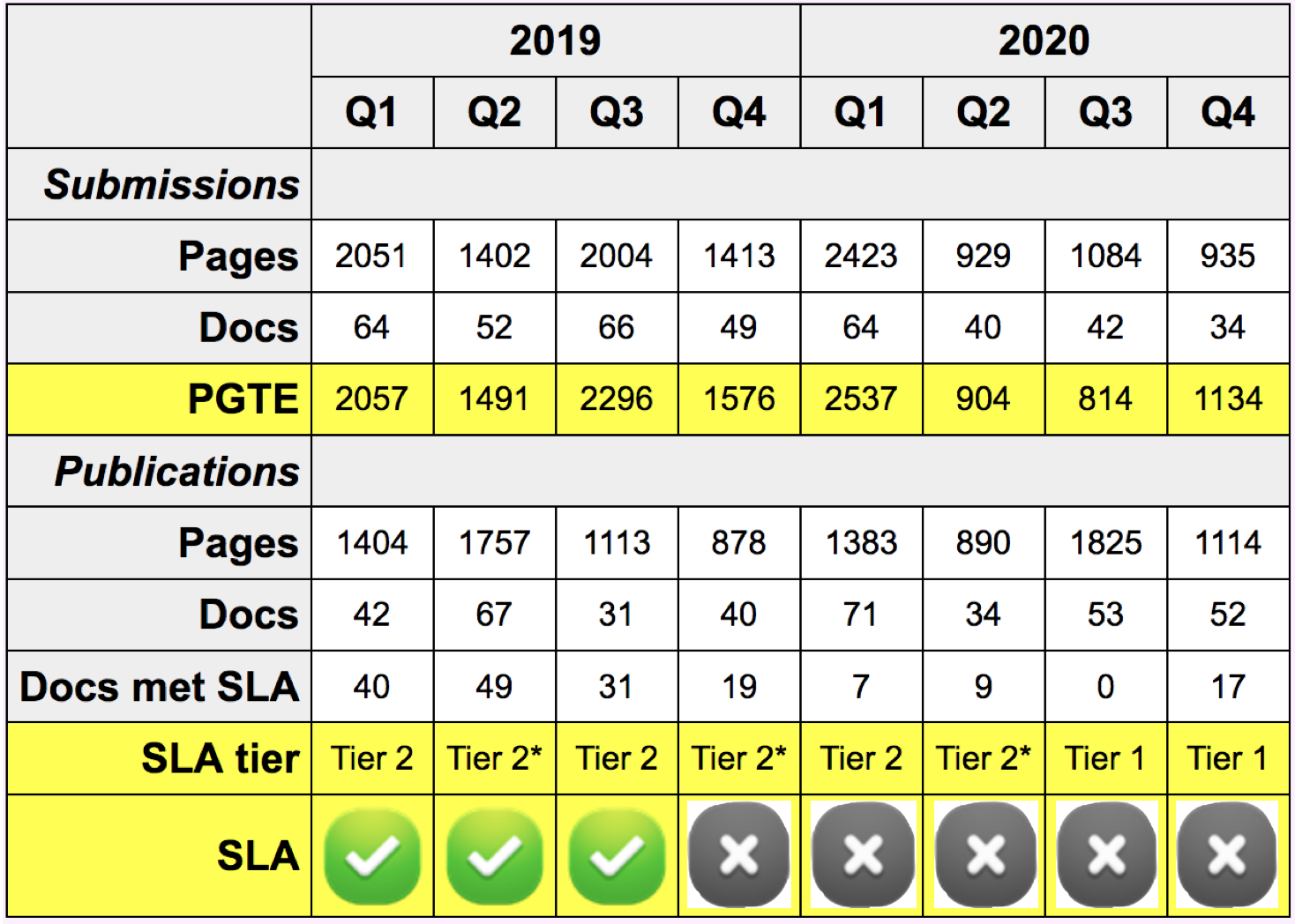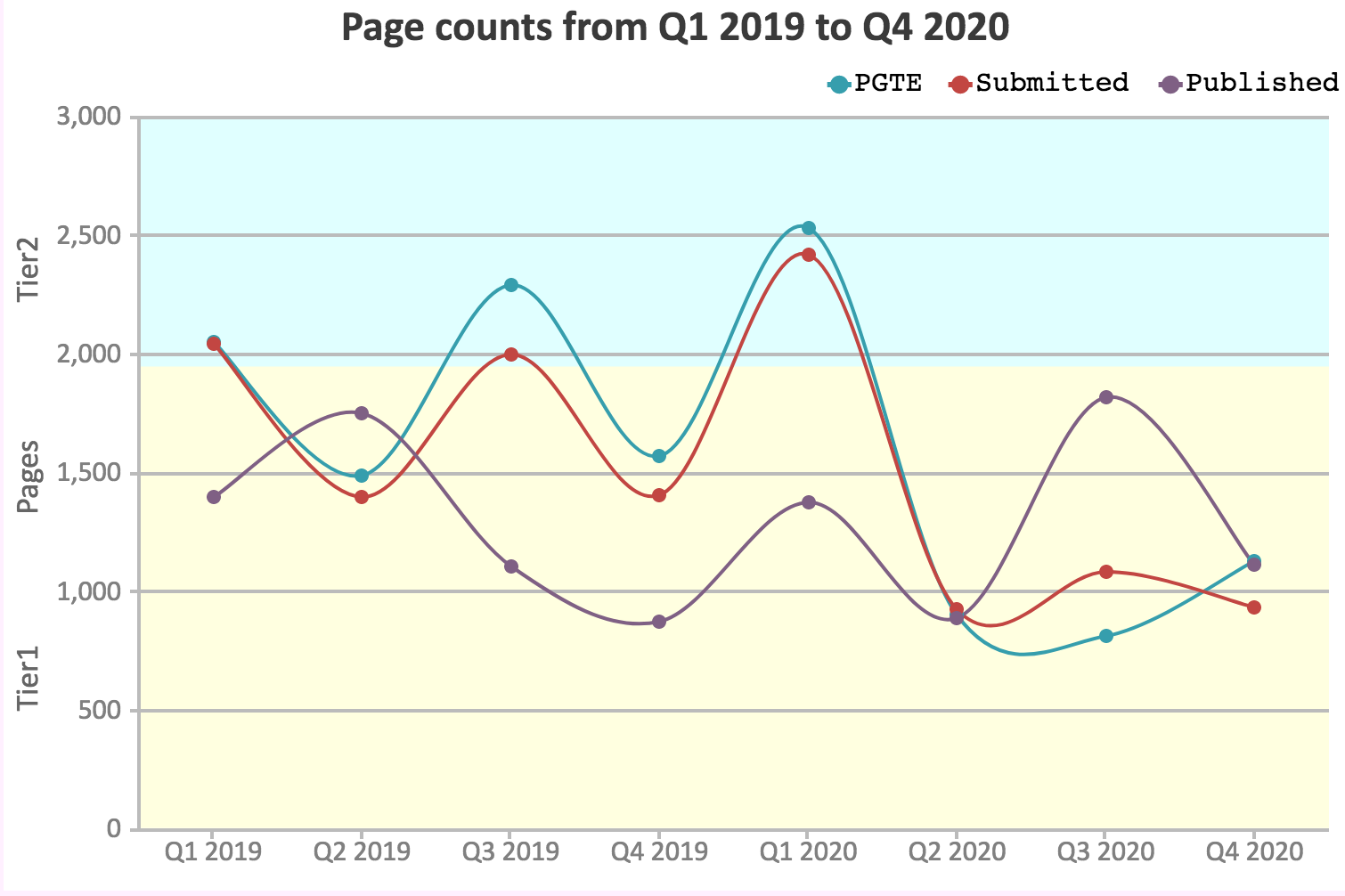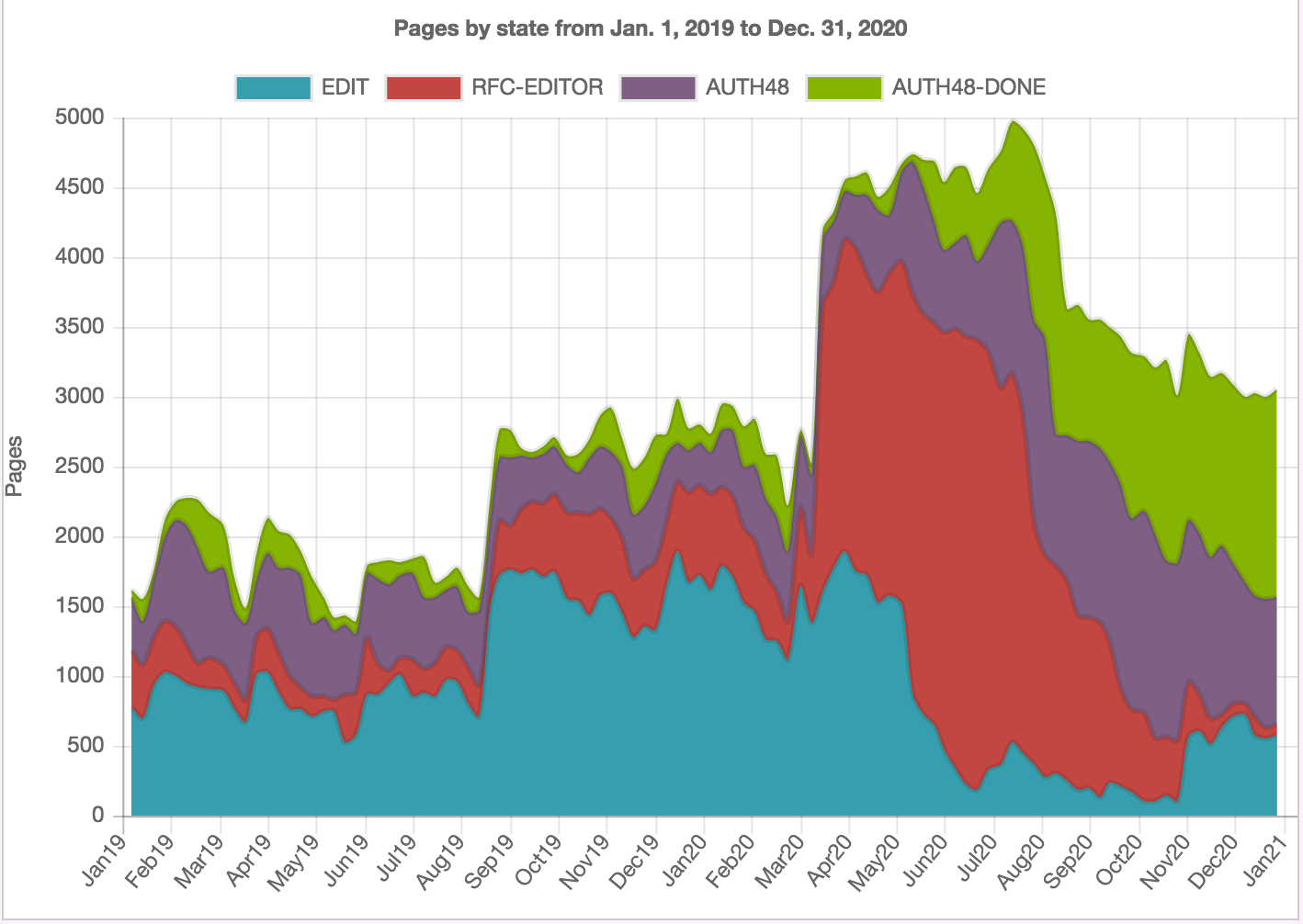Report Summary 2020
This page contains useful information regarding the performance of the RFC Production Center (RPC). It includes news items (updated as needed) and stats about production that are updated on a monthly and quarterly basis.
The RFC Editor strives to provide excellent and timely editorial service. To ensure the RFC Editor is providing the best possible service, the RPC regularly reviews its processes and liaises with the communities served. In addition, the rfc-interest mailing list is dedicated to discussing topics related to the RFC Editor.
Table of Contents
Service Level Agreement
The Service Level Agreement indicates the following:
- Tier 1: When there is a normal amount of input, the SLA is 67% of documents published within the period have an RFC Editor-controlled time that adds up to six weeks or fewer. Where ‘normal’ is defined as less than 1950 Pages gone to EDIT (PGTE).
- Tier 2: When there is a moderate burst in the amount of input, then the SLA shifts to 50% of documents published within the period have an RFC Editor-controlled time that adds up to 12 weeks or fewer within the given quarter or the subsequent quarter. Where a ‘moderate’ burst is defined as 1950 – 3072 (inclusive) Pages gone to EDIT (PGTE).
- Tier 3: When there is a large burst in the amount of input, then the SLA must be discussed and renegotiated. Where ‘large’ burst is defined as greater than 3072 Pages gone to EDIT (PGTE).
The figures below indicate whether we are meeting this goal.
“Tier 2*” indicates when Tier 2 is being applied in the “subsequent quarter” as mentioned above. The gray boxes denote the period during which the SLA has been suspended because of the v3 transition.
Figure 1. SLA Summary
Figure 2. PGTE and Pages Submitted & Published (by Quarter)
Figure 3. Number of Pages in Primary Processing States (i.e., no third-party holds)
Note that PGTE provides a more accurate picture of the RPC’s incoming workload for a given time period (than the number of documents entering the queue).
Also note that there is a ripple effect, as spikes in document counts in any one state may be due to clusters of documents moving through the queue together. A cluster does not move to the next state until the entire set is ready to be moved. You will often see bursts in EDIT, then RFC-EDITOR, and finally PUB, as the set of documents move through the states together to publication.
Generally speaking, the more documents there are in the queue, the longer it takes for documents to move through the queue.
Notes
Q4 2020 notes: With 209 RFCs published in 2020, and much of C238 in AUTH48-DONE (or nearing AUTH48-DONE), we’re seeing a return to more normal processing times. 33% of the documents were published in 6 weeks or less (Tier 1). This is a significant improvement from earlier quarters in the year.
Throughout the year, 209 RFCs were published. 35% of the documents were associated with a cluster. 26% of the RFCs were published within Tier 2 goals.
Note: A majority of the 50 documents comprsing C238 have extended processing times, so we do not expect the improved processing times to be reflected in the SLA until Q2 of 2021 (i.e., after C238 has been published).
Q3 2020 notes: We are a year out from transitioning to v3 XML and most issues have been resolved. We are starting to see a change in processing times, despite what Figure 1 is showing.
In Q3 of 2020, 23% of the RFCs published were within the Tier 2 processing times; so far in Q4 (October), 58% of the documents are being published within Tier 2 processing times. Note that we do not expect to meet the SLA this quarter as older documents finally clear out of the queue (in particular, if C238 is published), but we are returning to normal processing times.
As noted in Figure 2, publications have outpaced document submissions, which indicates that the queue size is decreasing. In addition, Figure 3 shows a significant drop in pages pending RFC Editor action, and fewer pages in any active state overall.
Q2 2020 notes: There was a submission spike at the end of Q1, which is not unexpected when there is IESG changeover. As shown in Figure 3, there was also a spike in the number documents in RFC-EDITOR state. This is because the major3ity of C238 (40+ documents) and the 600+ page draft-ietf-nfsv4-rfc5661sesqui-msns moved into RFC-EDITOR state. The RPC is actively working on releasing C238 to AUTH48.
Q1 2020 notes: We said goodbye to Heather Flanagan, who had been the RFC Series Editor since 2012, and welcomed John Levine as the Temporary RFC Series Project Manager.
As previously mentioned, the team is converting files to v3 XML as part of the editorial process. As files are converted, we continue to report bugs to the developer and seek guidance from various parties about the “right” way to format and tag some text (e.g., <artwork> or <sourcecode>).
Publications were slow in January. This is largely because C388 (14 IASA2 docs) didn’t complete AUTH48. Also, some staff time has been dedicated to C238 (41 active docs); portions of C238 will begin moving to AUTH48 shortly.
The RFC search results and info pages now have links to HTML files with inline errata, when available (these files exist for RFCs that have verified errata). For example: https://www.rfc-editor.org/search/rfc_search_detail.php?rfc=5234 links to https://www.rfc-editor.org/rfc/inline-errata/rfc5234.html.
Q4 2019 notes: With the RPC systems having been updated to handle v3 XML in Q3, the team successfully completed converting all AUTH48 documents to v3 XML and reinitiated AUTH48. Authors were asked to review the newly produced v3 XML and output files. 40 v3 RFCs have been published.
The team continues to convert the remaining files in the queue (outside of AUTH48) to v3 XML as part of the editorial process. As files are converted, we continue to report bugs to the developer and seek guidance from various parties about the “right” way to format and tag some text (e.g., <artwork> or <sourcecode>).
There are quite a few clusters working their way through the queue. C238 (41 active docs) and C388 (14 IASA2 docs) are actively being worked on. In addition, C340 (15 docs) was processed and published.
HTML files with approved technical errata in-line are now online for all RFCs published prior to the transition to v3 XML. For example, see RFC 5234 w/ inline errata.
Q3 2019 notes: The RFC Editor transitioned to v3 XML in September. Prior to the cutover, the RPC continued to familiarize itself with the v3 vocabulary and what makes a “good” v3 XML file, reported bugs to the developer, and updated procedures. These tasks are ongoing as the RPC converts the files in our queue to v3 XML.
For additional details, see the mail about the transition and the RSE wiki.
Clusters, clusters, clusters…
A majority of cluster 238 entered the queue, which means 35 documents (over 1000 pages) were released into the edit queue at one time, pushing us into tier 2 of the SLA. This caused a spike in the queue; see Figures 2 and 3.
In addition, the RPC is actively working through a majority of cluster 340. 12 of the 15 documents are being processed.
Q2 2019 notes: The submission rate is average. The publication rate is up compared with the previous four quarters.
The RPC continues to test the XMLv3 tools in preparation for the approaching transition. In addition, they are examining and updating their processes to account for XMLv3 tools and the new formats as they work to meet the transition timeline.
Also related to v3 format work, HTML files for the existing RFCs are available from the RFC Editor site. This means that each RFC published before the XMLv3 era will have an HTML file styled similarly to the current HTML files offered by tools.ietf.org. This allows consistent handling of links to RFCs, regardless of whether the RFC was produced before or after the transition to XMLv3.
Q1 2019 notes: As can be seen in Figures 1 and 2, submissions and PGTE increased, as is common when there is changeover in the IESG. 14 documents (442 pages) were submitted in the last week of March, which pushed us into Tier 2 of the SLA.
The number of published pages have been steady over the last three quarters. As shown in Figure 3, a significant number of pages were published in March. On average, 35% of the documents published per year are part of a cluster. So far this year, 50% of the RFCs have been part of a cluster.
Figure 2 shows that document submissions and PGTE are on the rise. This is shaping up to be the RPC’s toughest year yet, as it appears that a) we experienced the usual Q1 document surge associated with AD turnover, b) the record-breaking cluster 238 will soon be released into the EDIT queue, and c) XMLv3-related tasks are at an all-time high as the RPC prepares to transition to XMLv3 during this calendar year.
The RPC has also completed a data cleanup project so that all “never issued” values are handled in a consistent manner and made errata in JSON format available to public.
Thanks to Darius Kazemi, an amateur Internet historian, complete PDFs of RFC 2 and RFC 270 are now available.
The RPC responded to three legal requests.
2018 notes: 208 RFCs were published; 35% of these were associated with a cluster. 98% of the documents were published within Tier 2 goals. 2018 has been a very busy year, even though the submission and publication rates were low. For example, the team has made ISE transitional updates, taken on additional tasks regarding YANG (format checks), experimented with AUTH48 using GitHub, started using id2xml as part of our production process, and tested XMLv3-related tools and held various discussions throughout.
Other Reports
| Report | Description |
|---|---|
| Current Queue (sortable) | A list of all of the documents in the RFC Editor queue, ordered by state. (Updated dynamically) |
| Queue Summary | RFC Editor queue summary (Updated weekly) |
| Comprehensive Sub/Pub Stats | Detailed submission and publication data |
| Reports Archive | Pre-2014 reports (Was updated monthly) |
| Annual Publication Rate | Bar graph showing the number of RFCs published per year since 1969. (Updated annually). |
| RFC Editor Reports at IETF | Summary of the RFC publication process, including the state of the queue and a breakdown of the reasons for any long delays in the publication process. The report also may include recent changes in policy and improvements in tools or procedures. (Updated quarterly) |
| RFC Errata Reports | Summary of errata reports and their status, stream, and type. |
| RFC Status Changes (post-publication) | List of the RFCs whose statuses have changed since publication. (Updated as needed) |
This page is archived annually; see 2014 • 2015 • 2016 • 2017 • 2018 • 2019



